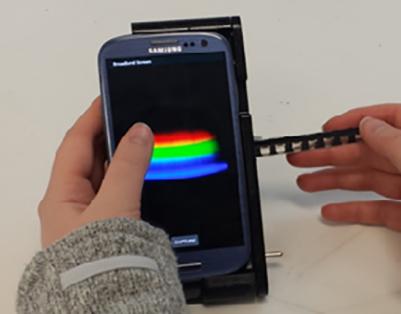New handheld spectral analyzer uses power of smartphone to detect disease

The spectral transmission-reflectance-intensity (TRI)-Analyzer attaches to a smartphone and analyzes patient blood, urine, or saliva samples as reliably as clinic-based instruments that cost thousands of dollars. Credit: Department of Bioengineering, University of Illinois at Urbana-Champaign
“Our TRI Analyzer is like the Swiss Army knife of biosensing,” said Cunningham, the Donald Biggar Willett Professor of Engineering and director of the Micro + Nanotechnology Lab at Illinois. “It's capable of performing the three most common types of tests in medical diagnostics, so in practice, thousands of already-developed tests could be adapted to it.”
In a recently published paper, Cunningham's team used the TRI Analyzer to perform two commercially available assays–a test to detect a biomarker associated with pre-term birth in pregnant women and the PKU test for newborns to indirectly detect an enzyme essential for normal growth and development. Their tests results were comparable to those acquired with clinic-grade spectrometer instrumentation.
“The TRI Analyzer is more of a portable laboratory than a specialized device,” said Kenny Long, an MD/PhD student and lead author of the research study.
Among the many diagnostic tests that can be adapted to their point-of-care smartphone format, Long said, is an enzyme-linked immunosorbent assay (ELISA), which detects and measures a wide variety of proteins and antibodies in blood and is commonly used for a wide range of health diagnostics tests. The system is capable of detecting the output of any test that uses a liquid that changes color, or a liquid that generates light output (such as from fluorescent dyes).
The TRI Analyzer operates by converting the smartphone camera into a high-performance spectrometer. Specifically, the analyzer illuminates a sample fluid with the phone's internal white LED flash or with an inexpensive external green laser diode. The light from the sample is collected in an optical fiber and guided through a diffraction grating into the phone's rear-facing internal camera. These optical components are all arranged within a 3D-printed plastic cradle.
The TRI Analyzer can simultaneously measure multiple samples by using a microfluidic cartridge that slides through an opening in the back of the cradle. This ability to analyze multiple samples quickly and reliably makes the Analyzer suitable for patients who lack convenient access to a clinic or hospital with diagnostic test facilities or for patients with urgent health situations requiring rapid results.
“Our Analyzer can scan many tests in a sequence by swiping the cartridge past the readout head, in a similar manner to the way magnetic strip credit cards are swiped,” said Long.
In addition to its applications in health diagnostics, Cunningham said the TRI Analyzer can also be applied to point-of use applications that include animal health, environmental monitoring, drug testing, manufacturing quality control, and food safety. The patented technology is available for license.
Media Contact
All latest news from the category: Information Technology
Here you can find a summary of innovations in the fields of information and data processing and up-to-date developments on IT equipment and hardware.
This area covers topics such as IT services, IT architectures, IT management and telecommunications.
Newest articles

NASA: Mystery of life’s handedness deepens
The mystery of why life uses molecules with specific orientations has deepened with a NASA-funded discovery that RNA — a key molecule thought to have potentially held the instructions for…

What are the effects of historic lithium mining on water quality?
Study reveals low levels of common contaminants but high levels of other elements in waters associated with an abandoned lithium mine. Lithium ore and mining waste from a historic lithium…

Quantum-inspired design boosts efficiency of heat-to-electricity conversion
Rice engineers take unconventional route to improving thermophotovoltaic systems. Researchers at Rice University have found a new way to improve a key element of thermophotovoltaic (TPV) systems, which convert heat…



